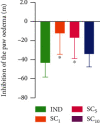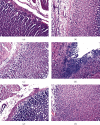Sanguinarine-Chelerythrine Fraction of Coptis chinensis Exerts Anti-inflammatory Activity in Carrageenan Paw Oedema Test in Rats and Reveals Reduced Gastrotoxicity
- PMID: 35340213
- PMCID: PMC8942652
- DOI: 10.1155/2022/1504929
Sanguinarine-Chelerythrine Fraction of Coptis chinensis Exerts Anti-inflammatory Activity in Carrageenan Paw Oedema Test in Rats and Reveals Reduced Gastrotoxicity
Abstract
Inflammatory diseases are a common therapeutic problem and nonsteroidal anti-inflammatory drugs are not deprived of side effects, of which ulcerogenic activity is one of the most frequent. The aim of the study was to evaluate the anti-inflammatory activity of the sanguinarine-chelerythrine (SC) fraction of Coptis chinensis and its influence on the integrity of gastric mucosa. The study was conducted on sixty male rats randomly divided into six experimental groups: two control groups (a negative control group CON and a positive control group CAR); three groups receiving an investigational fraction of C. chinensis (1, 5, 10 mg/kg i.g.) named SC1, SC5, and SC10, respectively; and a group receiving indomethacin (IND) (10 mg/kg i.g.) as a reference drug. In all animals, the carrageenan-induced paw oedema was measured; PGE2 release, TNFα production, and MMP-9 concentration in inflamed tissue were determined. Additionally, the macroscopic and microscopic damage of gastric mucosa was evaluated. Administration of SC dose-dependently inhibited the second phase of carrageenan rat paw oedema and PGE2 release, decreased the production of TNFα, and reduced the concentration of MMP-9, and the efficacy of the highest dose was comparable to the effect of IND. Contrary to IND, no gastrotoxic activity of SC was detected. The investigated sanguinarine-chelerythrine fraction of C. chinensis seems to be a promising candidate for further research on new anti-inflammatory and analgesic drugs characterized with a safer gastric profile compared to existing NSAIDs.
Copyright © 2022 Maciej Danielewski et al.
Conflict of interest statement
The authors declare that they have no conflicts of interest.
Figures







References
-
- WHO. Monographs on Selected Medicinal Plants VOLUME 3 . WHO; 2007.
-
- Meng F.-C., Zheng-Feng W., Yin Z.-Q., Lin L.-G., Wang R., Zhang Q.-W. Coptidis rhizoma and its main bioactive components: recent advances in chemical investigation, quality evaluation and pharmacological activity. Chinese Medicine . 2018;13(1):p. 13. doi: 10.1186/s13020-018-0171-3. - DOI - PMC - PubMed
-
- Park S. M., Min B.-G., Jung J. Y., et al. Combination of pelargonium sidoides and Coptis chinensis root inhibits nuclear factor kappa B-mediated inflammatory response in vitro and in vivo. BMC Complementary and Alternative Medicine . 2018;18(1):p. 20. doi: 10.1186/s12906-018-2088-x. - DOI - PMC - PubMed
Publication types
MeSH terms
Substances
LinkOut - more resources
Full Text Sources
Medical
Miscellaneous

